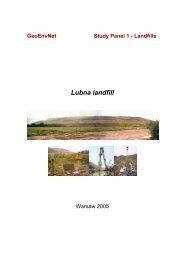24 R. Hryniewski, W. Mądry, D. Gozdowski, B. Roszkowska-Mądrations were in the form of quantitative as well as categorized variables (nominal or ordinal,expressed on a discrete numerical (i.e. rating) scale. On the basis of the answers obtainedin the survey more than 40 diagnostic variables were created.Diagnostic variablesIn order to identify the typology of the studied farms in terms of the farming systems,a relatively small number of key diagnostic variables is chosen, making sure that theyare essential in every aspect of the farming systems for the specific purpose of identifyingtheir typology [Kostrowicki 1977, Duvernoy 2000, Köbrich et al. 2003, Iraizoz et al.2007, Blazy et al. 2009, Chavez et al. 2010, Zawadka 2010]. In addition, these variablesshould not be strongly correlated; they should, however, show significant variation, suchthat the coefficient of variation is not lower than 50% [Köbrich et al. 2003, Serrano Martínezet al. 2004a, Thapa and Rasul 2005, Ruiz et al. 2009]. Taking into consideration theaim of this work and the methodological and statistical principles, 15 diagnostic variableswere chosen (Table 1).Table 1. Definitions of the diagnostic variables included in the analysis of the diversity andtypology of the farming systems on tobacco farmsTabela 1. Określenie badanych zmiennych uwzględnianych w analizie zróżnicowania i typologiisystemów produkcji w gospodarstwach rolniczych zajmujących się uprawą tytoniuVariableNaturalresourcesHumanResourcesTechnicalresourcesStructure ofproductionProductioninputVariabledesignationDefinition of the variable UnitsX1 Soil quality (weighted average soil quality class) rational numberX2 Share of grasslands in utilized agricultural area (UAA) %X3 Farm owner’s level of education a) ordinal scaleX4X5Workers employed in farm agricultural production per 1 haof UAANumber of innovative investments and productionimprovements made on the farm in the last 5 yearsrational numbernatural numberX6 Farm area haX7 Share of cereals in arable area (AA) %X8 Share of tobacco in AA %X9 Cattle density LSU ha –1 AAX10 Supply of organic fertilizers ton ha –1 yr –1X11 Supply of NPK fertilizers kg ha –1 yr –1X12 Agricultural production intensity index b)Yields X13 Yield of dried tobacco leaves from 2009 harvest ton ha –1 yr –1IncomestructureX14Contribution of agricultural production to total farmhousehold incomes%X15 Contribution of tobacco production to total farm incomes %a) 1 – elementary, 2 – vocational secondary, 3 – secondary, 4 – post-secondary, 5 – universityb) Agricultural production intensity index calculated on the basis of the normalized variables: cattle and pigsdensity, supply of NPK fertilizers, share of tobacco in AA (Herzog et al. 2006, Mądry et al. 2010)Source: Author’s elaboration.Źródło: Opracowanie własne.Acta Sci. Pol.
Typology of tobacco-based farming systems at the farm level in south-eastern Poland 25Statistical analysis of dataThe methodology of the statistical analysis applied here consists of three stages [Köbrichet al. 2003, Serrano Martínez et al. 2004a, b, Blazy et al. 2009, Carmona et al. 2010,Mądry et al. 2010]. In the first stage, a descriptive assessment of the variation in eachdiagnostic variable was carried out, using univariate statistical parameters.In the second stage, a Principal Component Analysis (PCA) was performed for allthe 15 diagnostic variables chosen. The analysis consists in creating mathematicallyp uncorrelated linear functions (principal components, PCs) for p original (observed) variables(here diagnostic variables) of the objects under study, each of which explains (captured,account for) the largest possible portion of the objects’ variance for all the variablesbeing analysed. A large proportion of the variance can be explained by only a few factors,usually two or three ones. This can occur when the original variables are rather highly correlated.Each PC can be interpreted as a common factor, understood as a substantive sourceof variation, determining the variables which are correlated with that component as well asbeing mutually correlated. The PCA was conducted on 15 diagnostic variables after standardizationin order to eliminate the effect of a different scale of the variables [Krzanowski2000, Hair et al. 2006]. In the third stage, a cluster analysis was performed with the Ward’smethod, using squared Euclidean distance on the first five principle components, for whichthe eigenvalues were higher than 1 [Krzanowski 2000, Köbrich et al. 2003, Serrano Martínezet al. 2004b, Hair et al. 2006, Chavez et al. 2010]. This method enables us classifyingstudied farms into homogenous but distinct groups in terms of all the diagnostic variablesunder consideration. These groups are also homogenous in terms of the farming systemsexisting in the range of the farms. Then, each of these farm groups identifies a particulartype of farming system within the population of the tobacco farms studied.GENERAL CHARACTERISATION OF FARMS IN TERMS OF INDIVIDUALDIAGNOSTIC VARIABLESThe estimates of the common statistical parameters for the 15 diagnostic variables(Table 2) indicate that tobacco farms in south-eastern Poland show highly variation formajority of the studied farming system descriptors.Characteristics and interpretation of the most important principal componentsThe first Principal Component (PC1): Intensification and specialization in cattleproductionThe first principal component (PC1) accounted for 23% of the total variation in thesurveyed sample of tobacco farms (Table 3). This most important principal componentwas significantly negatively correlated (|r|> 0.5) with the number of innovations (X5),farm area (X6), cattle density (X9), organic fertilizer use (X10), NPK fertilizer use (X11)and the production intensity index (X12). PC1 was also significantly positively correlatedwith contribution of tobacco production to total farm incomes (X15), which was negativelycorrelated with the important diagnostic variables just mentioned. For that reason,PC1, as factor 1, was called Intensification and specialization in cattle production.Oeconomia 10 (1) 2011
- Page 6 and 7: 6 A. Gawrońska, S. Paszkowskicultu
- Page 8 and 9: 8 A. Gawrońska, S. Paszkowskinumbe
- Page 10 and 11: 10 A. Gawrońska, S. PaszkowskiTabl
- Page 12: 12 A. Gawrońska, S. PaszkowskiTabl
- Page 15 and 16: The distribution of social security
- Page 17 and 18: %180,0160,0140,0120,0100,080,060,04
- Page 19: The distribution of social security
- Page 22 and 23: 22 R. Hryniewski, W. Mądry, D. Goz
- Page 26 and 27: 26 R. Hryniewski, W. Mądry, D. Goz
- Page 28 and 29: 28 R. Hryniewski, W. Mądry, D. Goz
- Page 30 and 31: 30 R. Hryniewski, W. Mądry, D. Goz
- Page 32 and 33: 32 R. Hryniewski, W. Mądry, D. Goz
- Page 35 and 36: Oeconomia 10 (1) 2011, 35-43EDUCATI
- Page 37 and 38: Education as an element of competit
- Page 39 and 40: Education as an element of competit
- Page 41 and 42: Education as an element of competit
- Page 43: Education as an element of competit
- Page 46 and 47: 46 E. Majewski, P. Sulewski, M. Rag
- Page 48 and 49: 48 E. Majewski, P. Sulewski, M. Rag
- Page 50 and 51: 50 E. Majewski, P. Sulewski, M. Rag
- Page 52 and 53: 52 E. Majewski, P. Sulewski, M. Rag
- Page 54 and 55: 54 E. Majewski, P. Sulewski, M. Rag
- Page 56 and 57: 56 E. Majewski, P. Sulewski, M. Rag
- Page 58 and 59: 58 L. Mazal, K.J. RowlesIn the West
- Page 60 and 61: 60 L. Mazal, K.J. RowlesThe most im
- Page 62 and 63: 62 L. Mazal, K.J. RowlesGDPt= GDP0+
- Page 64 and 65: 64 L. Mazal, K.J. RowlesTHE TIME SE
- Page 66 and 67: 66 L. Mazal, K.J. RowlesTable 4. Ac
- Page 68 and 69: 68 L. Mazal, K.J. RowlesNelson Ch.R
- Page 70 and 71: 70 A. Ptak-Chmielewskastatistics, w
- Page 72 and 73: 72 A. Ptak-Chmielewska3025birth rat
- Page 74 and 75:
74 A. Ptak-ChmielewskaSECTOR OF ACT
- Page 76 and 77:
76 A. Ptak-Chmielewskabirth rate fo
- Page 78 and 79:
78 A. Ptak-Chmielewskawere trade fi
- Page 80 and 81:
80 A. Ptak-ChmielewskaREFERENCESBal
- Page 83 and 84:
Oeconomia 10 (1) 2011, 83-95THE EFF
- Page 85 and 86:
The effi ciency of selected real es
- Page 87 and 88:
The effi ciency of selected real es
- Page 89 and 90:
Table 1. Efficiency of real estate
- Page 91 and 92:
The effi ciency of selected real es
- Page 93 and 94:
The effi ciency of selected real es
- Page 95:
The effi ciency of selected real es
- Page 98 and 99:
98 J. Sosnowski, G.A. CiepielaJalin
- Page 100 and 101:
100 J. Sosnowski, G.A. Ciepiela2007
- Page 102 and 103:
102 J. Sosnowski, G.A. CiepielaTabl
- Page 104 and 105:
104 J. Sosnowski, G.A. CiepielaTabl
- Page 106 and 107:
106 J. Sosnowski, G.A. Ciepiela1400
- Page 108 and 109:
108 J. Sosnowski, G.A. CiepielaOsek
- Page 110 and 111:
110 E. SzymańskaProducts by Activi
- Page 112 and 113:
112 E. Szymańskatroduced TFI which
- Page 114 and 115:
114 E. Szymańskabers of companies
- Page 116 and 117:
116 E. SzymańskaTable 3. Tourism v
- Page 118 and 119:
118 E. SzymańskaREFERENCESCoccossi
- Page 120 and 121:
120 J. WiśniewskaEvery society can
- Page 122 and 123:
122 J. WiśniewskaStatistical analy
- Page 124 and 125:
124 J. WiśniewskaCommon Agricultur
- Page 126 and 127:
126 J. WiśniewskaTable 3. An attem
- Page 128 and 129:
128 J. Wiśniewskathe application o
- Page 130 and 131:
130 J. Wiśniewskainstitutional cos
- Page 132 and 133:
132 J. Wiśniewskaemployed in agric
- Page 134 and 135:
134 J. WiśniewskaLong term viabili
- Page 136 and 137:
136 J. Wiśniewska--The level of re
- Page 139 and 140:
Oeconomia 10 (1) 2011, 139-148INNOV
- Page 141 and 142:
Innovativeness of food production e
- Page 143 and 144:
Innovativeness of food production e
- Page 145 and 146:
Innovativeness of food production e
- Page 147 and 148:
Innovativeness of food production e
- Page 149 and 150:
Oeconomia 10 (1) 2011, 149-158LOCAL
- Page 151 and 152:
Local governance activities in supp
- Page 153 and 154:
Local governance activities in supp
- Page 155 and 156:
Local governance activities in supp
- Page 157 and 158:
Local governance activities in supp
- Page 159 and 160:
Oeconomia 10 (1) 2011, 159-169CHANG
- Page 161 and 162:
Changes in rural women’s movement
- Page 163 and 164:
Changes in rural women’s movement
- Page 165 and 166:
Changes in rural women’s movement
- Page 167 and 168:
Changes in rural women’s movement
- Page 169:
Changes in rural women’s movement
- Page 172:
Ewa SzymańskaTourism function of M
















